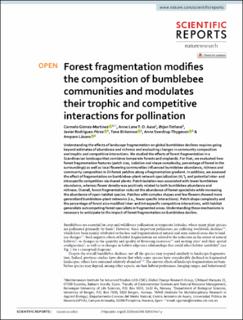| dc.contributor.author | Gómez-Martínez, Carmelo | |
| dc.contributor.author | Aase, Anne Lene Thorsdatter Orvedal | |
| dc.contributor.author | Totland, Ørjan | |
| dc.contributor.author | Rodríguez-Pérez, Javier | |
| dc.contributor.author | Birkemoe, Tone | |
| dc.contributor.author | Sverdrup-Thygeson, Anne | |
| dc.contributor.author | Lázaro, Amparo | |
| dc.date.accessioned | 2021-05-10T12:06:43Z | |
| dc.date.available | 2021-05-10T12:06:43Z | |
| dc.date.created | 2020-09-16T23:30:17Z | |
| dc.date.issued | 2020 | |
| dc.Published | Scientific Reports. 2020, 10 . | |
| dc.identifier.issn | 2045-2322 | |
| dc.identifier.uri | https://hdl.handle.net/11250/2754670 | |
| dc.description.abstract | Understanding the effects of landscape fragmentation on global bumblebee declines requires going beyond estimates of abundance and richness and evaluating changes in community composition and trophic and competitive interactions. We studied the effects of forest fragmentation in a Scandinavian landscape that combines temperate forests and croplands. For that, we evaluated how forest fragmentation features (patch size, isolation and shape complexity, percentage of forest in the surroundings) as well as local flowering communities influenced bumblebee abundance, richness and community composition in 24 forest patches along a fragmentation gradient. In addition, we assessed the effect of fragmentation on bumblebee–plant network specialization (H2′), and potential inter- and intraspecific competition via shared plants. Patch isolation was associated with lower bumblebee abundance, whereas flower density was positively related to both bumblebee abundance and richness. Overall, forest fragmentation reduced the abundance of forest-specialists while increasing the abundance of open-habitat species. Patches with complex shapes and few flowers showed more generalized bumblebee–plant networks (i.e., fewer specific interactions). Patch shape complexity and the percentage of forest also modified inter- and intraspecific competitive interactions, with habitat generalists outcompeting forest specialists in fragmented areas. Understanding these mechanisms is necessary to anticipate to the impact of forest fragmentation on bumblebee decline. | en_US |
| dc.language.iso | eng | en_US |
| dc.publisher | Nature Research | en_US |
| dc.rights | Navngivelse 4.0 Internasjonal | * |
| dc.rights.uri | http://creativecommons.org/licenses/by/4.0/deed.no | * |
| dc.title | Forest fragmentation modifes the composition of bumblebee communities and modulates their trophic and competitive interactions for pollination | en_US |
| dc.type | Journal article | en_US |
| dc.type | Peer reviewed | en_US |
| dc.description.version | publishedVersion | en_US |
| dc.rights.holder | Copyright The Author(s) 2020 | en_US |
| dc.source.articlenumber | 10872 | en_US |
| cristin.ispublished | true | |
| cristin.fulltext | original | |
| cristin.qualitycode | 1 | |
| dc.identifier.doi | 10.1038/s41598-020-67447-y | |
| dc.identifier.cristin | 1830658 | |
| dc.source.journal | Scientific Reports | en_US |
| dc.source.40 | 10 | |
| dc.identifier.citation | Scientific Reports. 2020, 10, 10872. | en_US |
| dc.source.volume | 10 | en_US |

